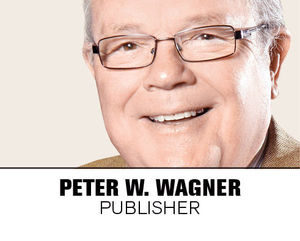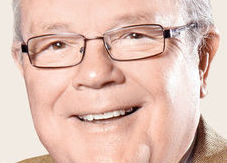A Kansas publisher emailed me last month seeking information on how to respond to businesses who say they’ve “placed their sale or event on Facebook so they don’t need a newspaper ad.” The businesses think, the publisher said, that “the Facebook posting is essentially free and generates at least some response without any cost to them.”
 The problem is nothing is ever truly free. Businesses depending on Facebook or any other social media to generate customers for a special sale or unique entertainment event are turning their backs on far greater potential profits than the little they’re saving in advertising dollars. As my son Jeff often reminds me, “No business ever saved their way out of debt.”
The problem is nothing is ever truly free. Businesses depending on Facebook or any other social media to generate customers for a special sale or unique entertainment event are turning their backs on far greater potential profits than the little they’re saving in advertising dollars. As my son Jeff often reminds me, “No business ever saved their way out of debt.”
Facebook’s limits
A sense of reverence has surrounded social media that has caused many businesses to drink “the internet’s bitter poison.”
It is true that Facebook has its appeal but it also has its faults. For every Facebook friend or follower who regularly reads a posting by a business or individual there’s at least one other who wishes he could permanently turn Facebook off. He’s tired of postings from some 30-year-ago classmate reporting, with pictures, what he had for lunch, supper and a midnight snack.
Digital media experts say Facebook pages – and business websites – need to feature new fresh, worthwhile information to retain active, truly interested Facebook friends. Those postings might come in the form of a daily blog, a recipe for that night’s meal, breaking credible news, a commentary on the local college’s football standings and stats or local reviews of the movies currently playing at the hometown theatre.
But this oversight of material requires time most business owners don’t have to invest. There are local and national services that do such work but their fees can be expensive and their material anything but local or unique to the specific business.
Facebook’s flaws
There are four upfront reasons local businesses should not depend only on a Facebook page to grow their business.
- The businesses’ Facebook friends recipient list is limited mostly to those who already know of and traditionally shop the store. Those customers may be the first to respond to an emailed price reduction on certain merchandise from knitting yarn to shotgun shells but they probably would have bought the items, when needed, at full price anyway.
- Many Facebook postings, especially those selling a product or service, quickly disappear after momentarily popping up on the receiver’s device. Facebook users are often frustrated by their inability to retrieve a recent message or picture let alone a commercial message not posted by Facebook itself. With millions of users worldwide, Facebook’s management says it is necessary to constantly edit and condense the material posted to accommodate the heavy flow of new messages.
- Facebook purposely limits the number of those on a business friends list who actually receive a specific promotional message to 5 percent. Facebook management explains this is done as a service to its members. If every user received every message, says Facebook, most users would be overwhelmed with messages. That 5 percent is determined by Facebook tracking the history of which friends most often read the sources postings. Interestingly, businesses can expand their reach to their full friends list by paying Facebook a user fee. So much for protecting the end user.
- Unlike locally managed community newspapers, many social media postings are poorly researched or even purposely untrue or decisive. Las Vegas Sheriff Joe Lombardo, the morning after the recent concert massacre, said law enforcement’s response could have been quicker except for the many erroneous internet reports (fake news) that there were multiple shooters firing guns from various locations. Later that day dozens of blogs and websites were wrongly reporting more fake news claiming knowledge the shooting was planned by the Russians, ISIS, the anti-Trump movement and untold others. All those claims have still to be proven.
Local newspapers provide the market with six C’s unique to media.
Local newspapers reach their immediate market with six unique values not always shared or observed by social media.
The most important, of course, is the creation of a sense of community. The local or regional newspaper provides families with information about everything that brings them together: high school sports, city government updates, local entertainment opportunities, weather, births, marriages and deaths.
The local newspaper encourages cooperation. Newspapers often take leadership in the bringing together of various interests to accomplish good for the community. They also recognize the efforts of others working for the good of the community and encourage support and involvement. The printed newspaper brings the masses together with one voice while many independent digital sites promote dissension.
Newspapers provide continuity. The community newspaper is the first recorder of local history and the source most often turned to for details regarding earlier historical events and activities and even family history. No other source can be so easily researched or duplicated.
The newspaper is respected for its credibility. Newspapers stake their reputations and financial future on researching the facts and providing every side of an issue. When questions arise the favored statement is, “It’s true, I read it in the newspaper”. That is in strong contract to “It must be true, I read it on the internet”. That last comment usually results in a condescending laugh from those in the crowd.
That credibility leads to the newspaper’s ability to create consensus. When it comes to making community decisions it is the newspaper that best gathers the opinions around both sides of the question. Broadcast reports the news in bits and pieces but seldom provides all the extenuating details. Social media sites provide many adverse and condescending opinions, often sell-fulfilling, that lead to greater dissention and controversy. The local newspaper is the one source that shares a common focus with the majority of people living in the market area.
Finally, newspapers have commitment. From the beat reporter to the executive editor, managing editor to the publisher the newspaper professional knows his role and purpose. Newspapers report the good and the bad, the entertaining and the devastating, the simple stories and the in-depth interviews, game scores, what is happening in the schools, on main street and with local industry.
Newspaper professionals care first of all about the community they live in and the future of the people who live there. That commitment alone is the main reason newspapers will never completely disappear from markets that support them in return.
 Nevada Press Association The best in Nevada journalism since 1924
Nevada Press Association The best in Nevada journalism since 1924




